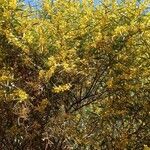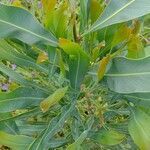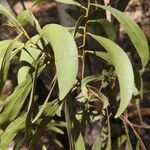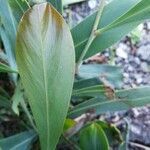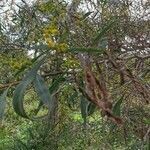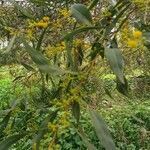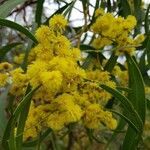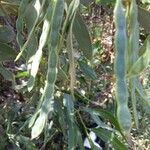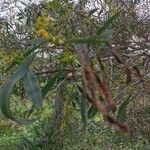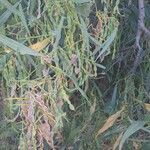Shrub or tree usually 3–8 m high. Branchlets sometimes pruinose, glabrous. Phyllodes often pendulous, falcately recurved to oblanceolate, pulvinus 4–7 mm long, much-narrowed at base, 8–15 (–22.5) cm long, (4–) 10–35 (–52) mm wide, obtuse to acute, coriaceous, glabrous, with prominent midrib, penninerved; gland often slightly exserted, sometimes 2, with the lowermost 3–45 mm above pulvinus. Inflorescences racemose; raceme axes mostly 2–9 cm long, stout, glabrous; peduncles (2–) 3–6 mm long, stout, glabrous; heads showy, globular to obloid, densely c. 40–80-flowered, bright golden, sometimes lemon yellow; bracteoles evident in buds; laminae subcircular, > 0.5 mm diam., dark brown to blackish, white-fimbriolate. Flowers 5-merous; sepals united. Pods linear, 5–13 cm long, 5–7 (–8) mm wide, firmly chartaceous to thinly coriaceous, glabrous. Seeds longitudinal, ±oblong, 5.5–6 mm long, somewhat shiny, black; aril clavate.
Unarmed shrub or tree up to 10 m high; young branchlets terete or almost so, glabrous. Leaves phyllodic, apparently simple, glabrous, 10-20 x (1)1.5-3 cm, obovate-lanceolate, distinctly falcate, mostly obtuse apically, narrowed basally, with a single main longitudinal nerve and finely but distinctly penninerved, margin nerve-like, with a fairly large marginal gland near the base (on young plants and coppice shoots bipinnate leaves are sometimes produced at the apex of the phyllode). Inflorescences globose, in axillary racemes or panicles. Flowers bright yellow; peduncles stout, up to 7 mm long. Calyx about 2/3 as long as the corolla, pubescent apically. Corolla ± glabrous.Podsbrown.6-12 x 0.4-0.7cm, straight or slightly curved, flattened, margins slightly constricted between some of the seeds, dehiscing longitudinally. Seeds dark brownish-black, 5-7 x 2.75-3.5 mm, smooth, compressed; caruncle conspicuous.
Unarmed small or medium-sized tree. Branchlets subterete or terete, quite glabrous as the remaining parts of the plant. Phyllodia rather long-stalked, lanceolate-falcate, top narrowed, obtuse, 7.5-15 cm, the larger ones often 2.5 cm wide in the middle, coriaceous, with one main nerve, penniveined, with vein-like margins, one marginal gland, rather large and close to the base; pulvinus long. Flowering heads composed of 50-100 flowers, in axillary and terminal racemes, those at the ends of the branches often aggregated into panicles. Pod straight or slightly curved, impressed between the seeds, 8-12 by 0.5-0.7 cm. Seeds longitudinal, ovate-oblong; funicle either not folded or with one or two very short folds at the base.
Tree or shrub, 2-10 m high. Branches terete when young, pendulous, glabrous, may have knobby galls. Leaves phyllodia, apparently simple, dull-green, glabrous, coriaceous, obovate-lanceolate, 100-200 x 15-30 mm, straight to falcate, narrowed basally, single prominent midvein, apex obtuse, young plants or coppice shoots may have bipinnate lamina at apex of phyllodia. Flowers globular heads in axillary racemes, bright yellow. Flowering time Aug., Sept. Pod brown, 60-120 x 4-7 mm, straight, flattened, margins slightly constricted between some seeds, dehiscent.
Shrub or tree to 20 m. Phyllodes falcate, with 1 central, longitudinal vein, dull green. Flowers in globose heads, bright yellow. Pods flat, slightly constricted between seeds.
